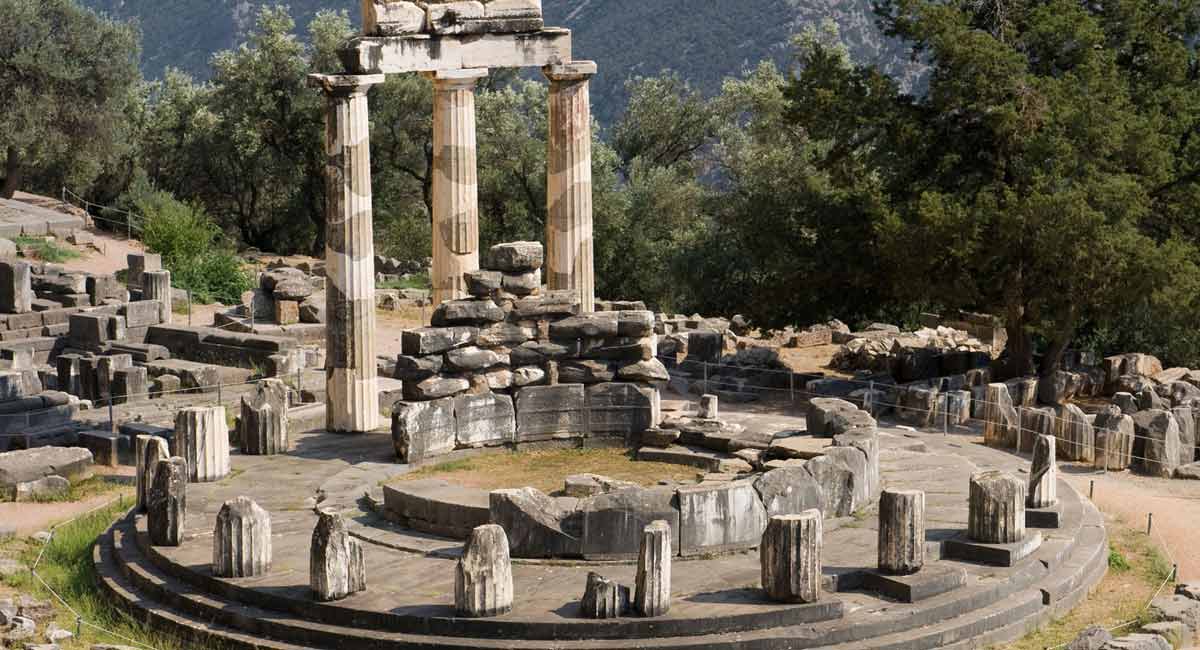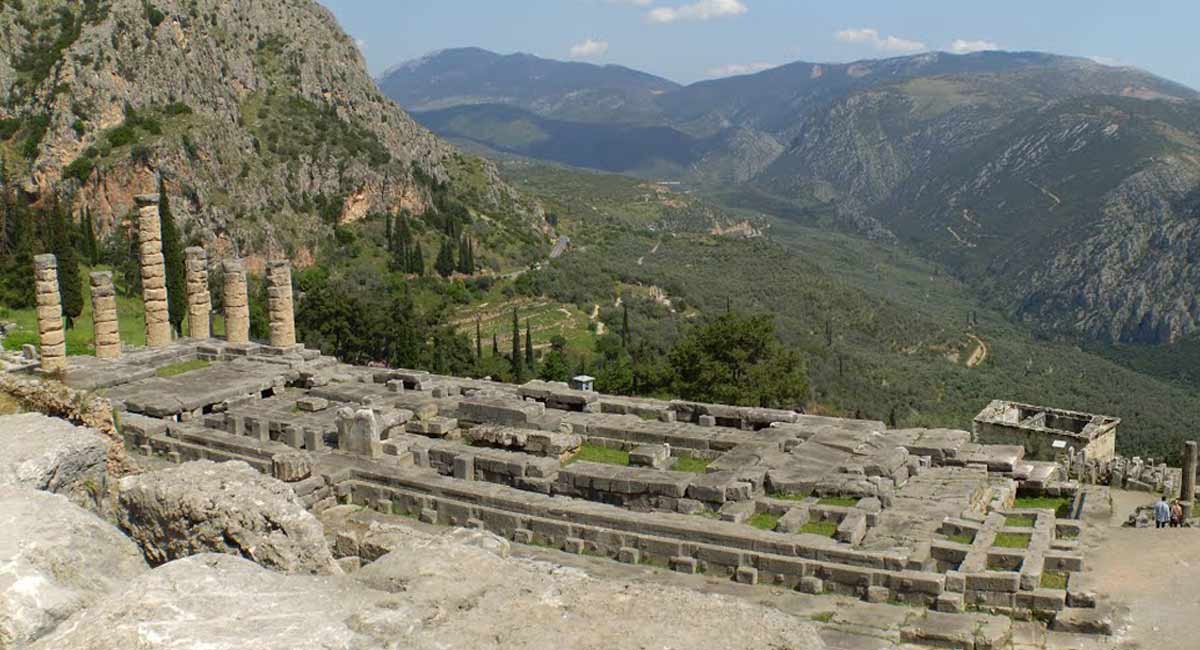DELPHI
Is famous as the ancient sanctuary that grew rich as the seat of the oracle that was consulted on important decisions throughout the ancient classical world. Moreover, it was considered as the navel (or centre) of the world by the Greeks as represented by the Omphalos. It occupies an impressive site on the south-western slope of Mount Parnassus overlooking the coastal plain to the south and the valley of Phocis. It is now an extensive archaeological site and the modern town is nearby.
It is recognised by UNESCO as a World Heritage Site in having had a phenomenal influence in the Ancient world, as evidenced by the rich monuments built there by most of the important ancient Greek city-states, demonstrating their fundamental Hellenic unity.
The site of Delphi is located in upper central Greece, on multiple plateaux/terraces along the slope of Mount Parnassus, and includes the Sanctuary of Apollo, the site of the ancient Oracle. This semicircular spur is known as Phaedriades, and overlooks the Pleistos Valley. In myths dating to the classical period of Ancient Greece (510-323 BC), the site of Delphi was believed to be determined by Zeus when he sought to find the centre of his "Grandmother Earth" (Ge, Gaea, or Gaia). He sent two eagles flying from the eastern and western extremities, and the path of the eagles crossed over Delphi where the omphalos, or navel of Gaia was found.
Earlier myths include traditions that Pythia, or the Delphic oracle, already was the site of an important oracle in the pre-classical Greek world (as early as 1400 BC) and, rededicated from about 800 BC, when it served as the major site during classical times for the worship of the god Apollo. Apollo was said to have slain Python, a "drako" a serpent or a dragon who lived there and protected the navel of the Earth. "Python" (derived from the verb πύθω (pythō), "to rot") is claimed by some to be the original name of the site in recognition of Python which Apollo defeated. The Homeric Hymn to Delphic Apollo recalled that the ancient name of this site had been Krisa. Others relate that it was named Pytho and that Pythia, the priestess serving as the oracle, was chosen from their ranks by a group of priestesses who officiated at the temple.
At the settlement site in Delphi, which was a post-Mycenaean settlement of the late 9th century, there is a steady increase in artifacts from the last quarter of the 8th century BC. Pottery and bronze work as well as tripod dedications continue in a steady stream, in comparison to Olympia. Neither the range of objects nor the presence of prestigious dedications proves that Delphi was a focus of attention for a wide range of worshippers, but the large quantity of high value goods, found in no other mainland sanctuary, certainly encourages that view.
Apollo's sacred precinct in Delphi was a panhellenic sanctuary, where every four years, starting in 586 BC[8] athletes from all over the Greek world competed in the Pythian Games, one of the four panhellenic (or stephanitic) games, precursors of the Modern Olympics. The victors at Delphi were presented with a laurel crown (stephanos) which was ceremonially cut from a tree by a boy who re-enacted the slaying of the Python.[8] Delphi was set apart from the other games sites because it hosted the mousikosagon, musical competitions.

These Pythian Games rank second among the four stephanitic games chronologically and in importance. These games, though, were different from the games at Olympia in that they were not of such vast importance to the city of Delphi as the games at Olympia were to the area surrounding Olympia. Delphi would have been a renowned city whether or not it hosted these games; it had other attractions that led to it being labeled the "omphalos" (navel) of the earth, in other words, the centre of the world.

In the inner hestia ("hearth") of the Temple of Apollo, an eternal flame burned. After the battle of Plataea, the Greek cities extinguished their fires and brought new fire from the hearth of Greece, at Delphi; in the foundation stories of several Greek colonies, the founding colonists were first dedicated at Delphi. Delphi is perhaps best known for the oracle of the Pythia in the form of the sibyl or priestess at the sanctuary dedicated to Apollo. According to Aeschylus in the prologue of the Eumenides, the oracle had origins in prehistoric times and the worship of Gaea, a view echoed by H.W. Parke.
One tale of the sanctuary's discovery states that a goatherd, who grazed his flocks on Parnassus, one day observed his goats playing with great agility upon nearing a chasm in the rock; the goatherd noticing this held his head over the chasm causing the fumes to go to his brain; throwing him into a strange trance. Apollo spoke through his oracle. She had to be an older woman of blameless life chosen from among the peasants of the area. Alone in an enclosed inner sanctum (Ancient Greek adyton - "do not enter") she sat on a tripod seat over an opening in the earth (the "chasm").
According to legend, when Apollo slew Python its body fell into this fissure and fumes arose from its decomposing body. Intoxicated by the vapours, the sibyl would fall into a trance, allowing Apollo to possess her spirit. In this state she prophesied. The oracle could not be consulted during the winter months, for this was traditionally the time when Apollo would live among the Hyperboreans. Dionysus would inhabit the temple during his absence.
While in a trance the Pythia "raved" – probably a form of ecstatic speech – and her ravings were "translated" by the priests of the temple into elegant hexameters. It has been speculated that the ancient writers, including Plutarch who had worked as a priest at Delphi, were correct in attributing the oracular effects to the sweet-smelling pneuma (Ancient Greek for breath, wind or vapour) escaping from the chasm in the rock. That exhalation could have been high in the known anaesthetic and sweet-smelling ethylene or other hydrocarbons such as ethane known to produce violent trances. Though this theory remains debatable the authors put up a detailed answer to their critics.
Ancient sources describe “laurel”, or Laurusnobilis, being used by the priestess, in order to inspire her prophecies. Several alternative plant candidates have been suggested including Cannabis, Hyoscyamus, Rhododendron and Oleander. Harissis claims that a review of contemporary toxicological literature indicates that oleander causes symptoms similar to those of the Pythia, and his study of ancient texts shows that oleander was often included under the term “laurel”.
The Pythia may have chewed oleander leaves and inhaled their smoke prior to her oracular pronouncements and sometimes dying from the toxicity. The toxic substances of oleander resulted in symptoms similar to those of epilepsy, the “sacred disease,” which may have been seen as the possession of the Pythia by the spirit of Apollo.
Elements
- Luxury Travel Service
- Theodoros Papandreou
- Laodikias 123 Nikaia Postcode 18451
- Privacy Policy
Menu

Number ΕΟΤ: 0207E8000055031
Copyright 2016 - 2019 © All rights Reserved. Designed by nextlevelweb.gr
